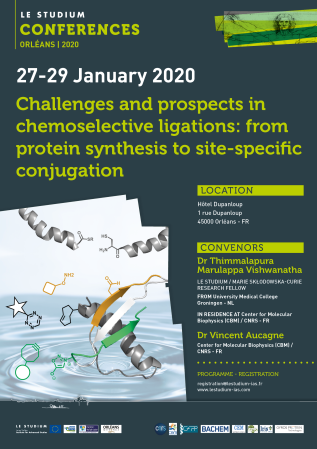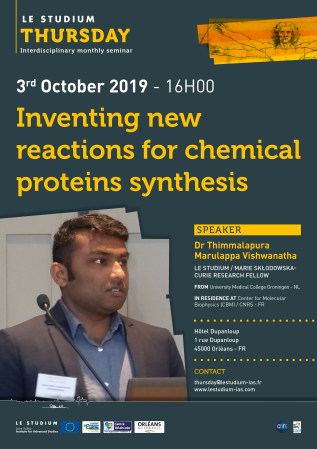Dr Thimmalapura Marulappa Vishwanatha

LE STUDIUM / Marie Skłodowska-Curie Research Fellow (2nd period)
Établissement d'origine
Collège universitaire de médecine de Groningue - NL
Laboratoire d'accueil
Centre de Biophysique Moléculaire (CBM) / CNRS - FR
Hôte scientifique
Dr Vincent Aucagne
PROJET
Development of novel chemoselective ligation techniques for protein synthesis
An ingenious stratagem useful to understand and modulate the structural and functional features of the proteins refers to the modification of their chemical structure. In this regard, the chemical synthesis of proteins appears a key tool, as it allows the unlimited modification of a polypeptide chain with any kind and number of labels. The last decade has seen the introduction of several techniques of chemical protein synthesis that allow the manipulation of proteins structure. Among these approaches, the Native Chemical Ligation (NCL) reaction appears as the most useful and advantageous strategy and numerous researches are currently ongoing on in this area. Many of the developed ligation methods have their own drawbacks. In particularly, NCL requires a cysteine residue as ligation site which is a rare amino acid. Many other synthetic strategies rely on the same reaction with the use of amino acid-derived β-amino thiols. However, their preparations require long multistep synthesis and an additional desulfurization step is necessary after NCL. Thus, the development of original chemical methods based on easily preparable starting materials could not only unlock major technological limitations of protein chemical synthesis but also provide alternative synthetic pathway to provide simple amides.
The project utilizes peptide thioacids as important coupling partner. Peptide thioacids will be coupled with peptide isocyanides using a known methodology, but to date only applied to small protected peptide segments: chemoselectivity and large protein synthesis will be studied in detail, requiring in particular the development of a synthetic route to unprotected peptide isocyanides. Secondly, following a similar strategy, peptide thioacids will be coupled to N-activated peptides (imidazolyl ureas) and the chemoselectivity of the reaction will be scrutinized.
Publications
Final reports
|
A novel strategy has been devised that allows a ligation of of thioacids and imidazolyl urea activated amines under aqueous conditions. This approach enables the traceless removal of imidazole and CO2 to directly generate the desired amide bond without affecting the side chain reactive side chain functional groups on the peptide chain. Meanwhile, the novel synthesis of peptide thioacid is also reported. |


